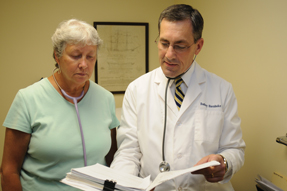How many are too many for CT scans?
As many as one-third of the 70 million imaging tests ordered during the year may not be needed. Experts attempt to determine whether repeated radiation scanning doses could prove potentially yet unintentionally harmful.
In 1980, 3 million computed tomography (CT) scans were performed in the U.S. In 2007, nearly 70 million were done. “We're higher [per capita in our use of CT scans] than almost any other industrialized country,” said Rebecca Smith-Bindman, MD, professor in residence of radiology, epidemiology/biostatistics, and obstetrics, gynecology, and reproductive medicine at the University of California, San Francisco.
“There's remarkably little research that has tried to quantify what we are getting out of this. How much of this imaging is helping patient care? How much of it may be completely unnecessary?” she added.

A study in the December 2010 issue of Radiology that reviewed data from the 1995-2007 National Hospital Ambulatory Medical Care Survey showed that the number of emergency department visits that included a CT examination increased from 2.7 million to 16.2 million, which was a 5.9-fold increase and a compound annual growth rate of 16%. The percentage of visits associated with CT increased from 2.8% to 13.9%, which was a 4.9-fold increase and a compound annual growth rate of 14.2%.
Findings like these have raised concerns among physicians and the public that this heavy use of CT scanning could actually lead to some negative, instead of positive, health consequences for patients.
“It's not clear that patients are having better outcomes, better health, which suggests that at least some of those tests probably didn't need to be done,” said Rita Redberg, MD, a cardiologist and professor of medicine at UCSF.
The issue of possible overuse of CT technology is currently attracting attention from payers, regulators and politicians, but may be dealt with most simply, and perhaps most effectively, by the decision making of individual physicians, experts said.
Why not to scan
Several potential negative effects of overuse have been identified. The risk of radiation-related cancers has been the most heavily publicized. A December 2009 study in Archives of Internal Medicine projected that as many as 29,000 excess cases of cancer could result from CT scans performed in 2007.
The risk would result not only from the number of scans being performed, but also from the dose of radiation in each, which can vary widely (an average of 13-fold) by facility, according to a study by Dr. Smith-Bindman published in the same issue of Archives.
Not all experts are convinced that this radiation exposure is likely to have negative health effects. Researchers' assumptions about the relationship between radiation and cancer are drawn from atomic bomb blasts, said Bruce Hillman, MD, professor of radiology at the University of Virginia in Charlottesville.
“What radiation physicists have done is to back-project that correlation to zero level of radiation and make the assumption that radiation is cumulative and if you get lots of CT scans, even though each one is a small dose, that that's an accumulated risk … and also that radiation at any level increases your chances even very slightly of getting a cancer down the line. That's what we live by, even though there's little direct data to support that,” he said.
The risk of cancer would vary depending on the body part and the age of the patient being scanned. “Younger patients are going to be more sensitive to exposure. Certain organs with rapidly dividing cells are going to be more sensitive to radiation,” Dr. Hillman said, citing testicles, thyroids and breasts as examples.
Regardless of interpretation of radiation risk, there are other reasons to be concerned about excessive use of scanning. “I don't think there's any question that the biggest risk of doing an unnecessary CT scan is an incidental finding that will lead to more invasive treatment,” said Howard Brody, MD, a family physician and director of the Institute for Medical Humanities at the University of Texas Medical Branch in Galveston.
However, the risk of these “incidentalomas” has not captured the public's attention as radiation risk has. “If you try to explain to the patient, ‘You could get cancer from the radiation,’ right away the patient knows what you're talking about. If you try to explain, ‘You know I might find an incidental finding and then this might happen and that might happen and this might happen and then you might be harmed,’ it's really hard for the patient to grasp that,” Dr. Brody said.
Unnecessary follow-up and patient harm can also result from scans that come back with false-positive results. Then there's the consequence that drives payers to be interested in the issue—unneeded exams obviously contribute to skyrocketing national health care costs.
“When you order an inappropriate exam, there's nothing good that can happen of it,” said Dr. Hillman. “The general estimate is that as many as a third of all imaging exams do not contribute to the care or the outcome of the patient. There's no data to support that number, but certainly it's a sizable fraction.”
Why so many?
A number of factors push physicians toward ordering scans when they're not needed, the experts said. For one, imaging has become a standard part of medical culture. “It's become expected that you're going to get an imaging test. The patient wants it, the referring doctor wants it, the specialist wants it,” said Dr. Smith-Bindman.
Patient desire for imaging often results from a misunderstanding of the quantity/quality equation, according to Dr. Brody. “A lot of our patients are just used to the idea that more is always better, that if my doctor orders lots of tests … that means my doctor really cares about me and I'm really getting the very best medical care,” he said.
A study in the December 2010 issue of Archives of Internal Medicine confirms this point. Non-traumatic abdominal pain patients were given a medical evaluation with or without a CT and other tests. Patient confidence in their exam was measured on a 100-point scale. Median patient confidence was 20 (95% CI, 16 to 25) compared with 90 (95% CI, 88 to 91) when laboratory testing and CT were included.
Perhaps most startling, of 365 patients who reported no previous CT, 142 (39%) had one documented in their electronic medical record.
Direct-to-consumer advertising by the manufacturers of scanners encourages patients' “more is better” assumption, said Dr. Hillman. And manufacturers aren't the only ones who gain financially from CT scans. “Imaging is extraordinarily profitable. It's profitable for the institution, for the emergency department, for the hospital, for the radiologists, for the urologists that own their own machines,” said Dr. Smith-Bindman.
Not scanning, on the other hand, can be costly in a different way, especially for busy internists who need to maintain high productivity. “It's a whole lot easier to first do the test, and find out if there is a problem and then contact the appropriate specialist, than to first contact the specialist, have the specialist see the patient, and then get the CT,” Dr. Smith-Bindman said.
“Sometimes it's just easier to say, ‘I guess I'll get an imaging exam, because it would just take me too long to continue to listen to this very hard-to-understand story or actually do a physical exam,’” described Dr. Hillman.
Solutions
The simplest solution to the problem of overtesting is for physicians to slow down and think, the experts said.
“There are times that we'd do just as well with clinical assessment—a good history and physical without an imaging test,” said Dr. Redberg. “It's important for any particular test to think about: Do I really need the information from this test? How is it going to change my plan? How will it lead to a different or better outcome?”
For doctors not certain of the answers to those questions, there may be an expert nearby who can help, said Dr. Hillman, who takes issue with the description of generalist physicians “ordering” a CT.
“It's gotten to be too much ordering and too little consultation. If there's ever a concern about that ratio—the long-term downstream risk of getting an imaging examination versus the benefit to the patient—a formal consultation, not just sending in the form, but a conversation either by e-mail, or on the telephone or in person, with an expert, a radiologist, is really what ought to occur.”
Consultation with a radiologist may also reduce the risk of inappropriate testing resulting from minimal or miscommunication. Many physicians order scans by CPT codes, which can be too broad. “For instance, there are only four CPT codes covering head CT scans, but in our practice, and in many others, there are at least 10 different head CT scan protocols that we actually do,” said Chris Sistrom, MD, MPH, PhD, vice-chair of radiology at the University of Florida in Gainesville.
There are also many tests besides CTs that may be worth considering, treadmill testing or echocardiograms for cardiac issues, or MRIs for some conditions. “Ultrasound scans are grossly underutilized in this country because physicians mostly can't read them as they can with the images on CT scans,” said Dr. Hillman, noting that the ultrasounds are also less cost-effective for radiologists.
Radiologists can present a potential solution to the problem of incidentalomas. “A good radiologist will tell the physicians these exist, but will also tell him or her that these have no importance to the patient,” said Dr. Hillman.
In some cases, it may also be appropriate for physicians to share some of the decision making with patients, especially if they're on the fence about whether the patients need the scan. “I might say, ‘Here are the pros of getting a scan. Here's the downside. Which do you think is more important?’ If … some patients request a CT scan and some don't, and they know what they're getting into, because we've informed them properly, that's an ideal decision-making mode,” said Dr. Brody.
Properly informing patients about the risks of scanning is a responsibility of the physician ordering the test, he noted. “We have to be upfront and warn our own patients and be part of the disclosure process in the office, not just put it all off on the radiology department,” Dr. Brody said.
Systemic changes
There are some aspects of the CT problem that physicians likely can't take on themselves, for example, the variation in radiation doses. In some highly publicized recent incidents, patients were found to have received much higher doses of radiation than needed. In response, a recent California law requires radiation doses to be recorded in patients' medical records, but Dr. Smith-Bindman doesn't think the situation will be resolved so simply.
“The manufacturers have made it nearly impossible to get this information out of the machines and into the medical record,” she said. “I'm not sure how most practices in the state are going to respond. They're in a state of panic because these data are very much hidden.”
She'd like to see either regulation or guidelines setting out acceptable doses for routine studies, and recently proposed a metric to the National Quality Forum that would help practices voluntarily review the doses they use for routine CT study types. “Alternatively, the FDA could get involved in setting standards, but they are very reticent about getting involved in legislating medicine. But they do [have standards] for mammography, so there is a precedent of their getting involved in quality improvement around the conduct of imaging.”
The FDA did recently offer some recommendations to CT scanner manufacturers on how to reduce the risk of patients receiving excess radiation, particularly from brain perfusion scans, including making dose-related information clearer and more accessible.
The Centers for Medicare and Medicaid Services has also taken a first step toward dealing with the issue of overuse of scans by supporting a demonstration project that provides ordering guidance for selected conditions. Other agencies, such as the National Institute of Biomedical Imaging and Bioengineering, are funding cost-effectiveness research on computerized radiology order entry systems that offer decision support (ROE-DS) to help physicians determine whether a scan is appropriate for a particular patient.
Physicians at Massachusetts General Hospital were among the first to develop and use one of these systems. Jeffrey Weilburg, MD, a psychiatrist and associate medical director of the MGH Physicians Organization, which implemented the system, explained how it works. “The doctor inputs signs, symptoms, known diagnoses, and special considerations via checkboxes on the computer screen. A decision support score appears once input is complete. A red score means, ‘Doc, we don't think this exam is likely to have high utility.’ Yellow, ‘We don't know. The evidence is equivocal.’ Or green, ‘Go ahead. This sounds sensible.’” When low scores appear, alternatives may be suggested, for example an MRI of the head instead of a CT of the head for a patient undergoing evaluation of dementia.
The system also warns physicians when they're ordering a scan of a body part that has already received multiple scans recently. This is a concept that internists need to consider even if they don't have a computer to help them with it, the experts said.
Ideally, patients' general radiation history should be collected and tracked, but physicians should pay particular attention to patients who have conditions, like kidney stones or inflammatory bowel disease, that might motivate frequent imaging. “Physicians really need to monitor the frequency,” said Dr. Hillman. “Both of the diseases tend to affect younger patients, therefore there is greater sensitivity to radiation and a longer period for them to contract cancer.”
Following introduction of the ROE-DS system at MGH, the growth of outpatient CT scans flattened, according to a study by Drs. Sistrom, Weilburg and others, published in Radiology in April 2009. They also found that physicians rapidly adjusted their ordering to comply with the system's recommendations (which were based on American College of Radiology appropriateness criteria).
“The fraction of tests that we would consider inappropriate that actually get scheduled and done starts out at about 25%, but very quickly, within a couple of months, it drops down to less than 5%,” said Dr. Sistrom.
It's possible that some ordering physicians are gaming the system by putting in inaccurate signs and symptoms in order to get tests approved, and that the ROE-DS process is deterring some physicians from ordering tests that should be done, he noted. However, preliminary results of a quality assessment comparing submitted indications for imaging tests with other parts of the medical record showed very high concordance.
RBMs
The program's developers are confident that their system is better at filtering CT orders than the most common alternative, which is for-profit radiology benefits management (RBM) companies that handle the preauthorization of tests for insurers.
“They claim that they're there just to make sure that the appropriate test gets done. They really don't care so much about that. It's really just a classic barrier to health services use. Evidence of that is that if you're persistent, you can get them to approve almost anything, but you've got to call back and call back … A lot of people just give up, which is precisely the point of the exercise,” said Dr. Sistrom.
Physicians need to take the lead in the effort to reduce inappropriate scans before it's done more aggressively by payers, agreed Dr. Brody. “They're going to be forced to take action. It will be a much less surgical and much less precise way to cut costs and everyone will suffer,” he said.
Currently, of course, most internists, especially those who aren't connected with hospital systems, are stuck with the RBMs. However, there's potential for ROE and decision support to move out into widespread practice. At MGH, outside practices can access the program through a secure Web link. Such Web-based systems could eventually become the norm for ordering imaging, predicted Dr. Sistrom.
Debate about direction
Although CT rates remain high, growth has slowed in recent years. “The rate of rise of CT scanning has leveled off. CT scanning was far outpacing general medical inflation from the year 2000 through 2005, but actually was lower than general medical inflation in 2008,” said Dr. Hillman.
The recession may have had an effect on scanning rates, and reduced reimbursement for the technical fees for scanning, enacted by Medicare in 2005 and cut even further in 2010, may also have decreased physicians' eagerness to scan, Dr. Hillman speculated.
He also suspects that fears of radiation, which he thinks have been excessive, have influenced scanning rates. “Some patients now, when their physician says ‘CT scan’, even if they need it, they may actually say, ‘No thanks, Doc,’” Dr. Hillman said. “Right now the pendulum has swung, I think, way too far, in that people are very afraid of what amounts to very low risk compared to the benefits of a needed exam.”
Yet, from Dr. Brody's perspective, that pendulum is still on the other side. “It would take us so long before we got anywhere near [underusing medical technology]. The pendulum in medicine is so far the other way,” he said.
Experts in both camps could likely agree, however, on Dr. Hillman's overarching piece of advice. “Ordering CT scans should always be a consideration of how much risk there is against the value of the information that you're going to get by ordering the scan,” he said.





